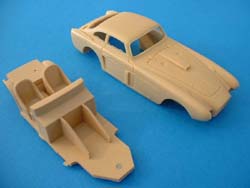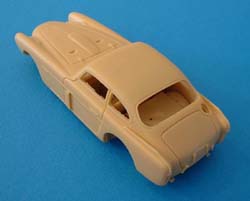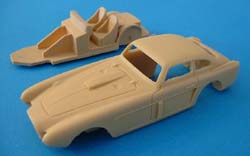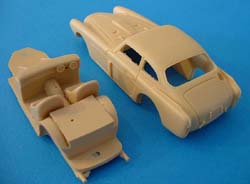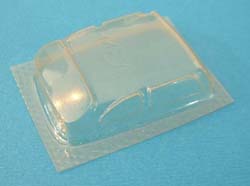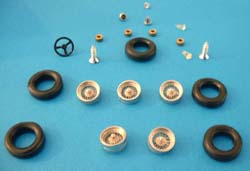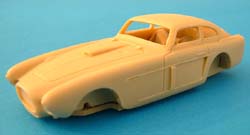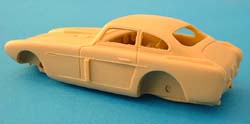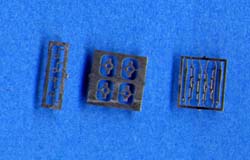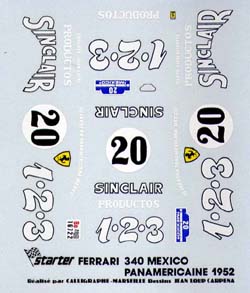Starter 1/43rd 1952 Ferrari 340 Mexico
|
 |
The Car
The 1952 Ferrari 340 Mexico was built expressly to compete in the grueling
2,000 mile Carrera Panamericana road race, which Ferrari had won the previous
year. The race was contested over five days, and featured eight different
stages. This race was important to Ferrari due to its extensive North
American press coverage at a time when this market was steadily growing.
The racing car was based on the production 340 America, with certain
detail differences. Both cars shared a 4.1 litre V-12 engine. The Mexico
had a revised camshaft, different carburetors, and a five-speed transmission
rather than the four-speed fitted to the America. The body was designed
by Michelotti and constructed by Vignale. A mere four 340 Mexicos were
produced, three coupes and one spyder. Only the coupes were entered in
the race. One crashed on the first stage, the second suffered transmission
failure on the third day, and the last, piloted by Jean Lucas and three-time
Le Mans winner Luigi Chinetti, finished third behind two Mercedes-Benz
300SLs.
The 340 Mexico handled well on long straight stretches of road, but
less well on winding narrow roads due to its long wheelbase (102.3 inches)
and narrow track (50 inches). To this day, the Ferrari 340 Mexico remains
one of the most exciting and aesthetically pleasing of the racing Ferraris,
as well as among the rarest.
The Kit
The kit comes well packaged in a sturdy cardboard box. This is a multimedia
kit, composed of resin, metal, and plastic. It contains 36 parts, two
of which are resin (the body and chassis), five plastic (including one
set of vacuformed transparencies), five rubber, 10 photo-etched metal,
five brass, and nine white metal. The photo-etched parts include the wire
wheel knock offs, the windshield wipers (each comprised of three pieces),
and hood pins.
The immediate and overwhelming impression is one of quality, care, and
thoughtful presentation. For example, the body and chassis are wrapped
in a cocoon of foam secured with a rubber band. The body casting is exceptional,
with details in scale thickness and with minimal flash confined to the
window frames. I found a single air bubble on the rear window surround.
The grille in particular is very well done, and the casting of the body
captures fully the feel and proportions of this exciting and purposeful
vehicle. The so-called “blac device” (for boundary layer air
control) which was attached to each door is well depicted. These were
intended to channel air into the rear fender openings to cool the large
drum brakes, but were more decorative than functional.
The only detail I found missing is the prominent clear “dust shield”
mounted to the hood, but this should be simple enough to make.
The chassis is one piece, and includes the seats, rear deck, instrument
panel, and a pair of exhaust pipes that could use a little help with a
micro drill to deepen their openings. The instrument faces themselves
are blank, and there is a hole drilled on the transmission tunnel to receive
the shift lever, which evidently you must fabricate yourself: my sample
didn’t have one.
The headlights have two pieces each, a clear lens and turned metal receptacle
which fits neatly into the fenders. The five wire wheels (one a spare
to install on the deck behind the seats) are hand laced (I think) and
are extremely well done. The only parts that give one any cause for concern
are the wipers, which are bit fiddly, and the single set of transparencies.
There is one decal option, printed by Carpena, for the Chinetti/Lucas
car. These are also very well done. The instructions-and I use the term
lightly-consist of a single folded black and white sheet with a picture
of the finished model, a small photo of the real car, one color callout
(“Body color: Red”) and one book reference. Underwhelming
to be sure, but this is a still a very nice kit!
Accuracy
The Car Folio website lists the following dimensions for the 340 Mexico:
Wheelbase of 102.3 inches, a length of 165.4 inches, and a width of 59.2
inches. I didn’t get out a ruler to check the kit against these
measurements, but I am satisfied that the kit accurately captures this
dynamic car.
Conclusion
This is an accurate and very nice kit of a historically important Ferrari.
It is also very simple in design, and will be easy to build for any careful,
competent, and patient modeler. Take your time, and I am confident that
you will be pleased with the results.
Unfortunately Starter kits are no longer in production, but they are
readily available online, through sources such as eBay. Certain Starter
kits are still carried by Grand
Prix Models. I received this kit as a wedding present from fellow
Internet Modeler contributor Stephen Tontoni, and no, my wife didn’t
mind a bit. Thanks, Stephen!
References
Print:
The Illustrated Ferrari Buyer’s Guide by Dean Batchelor, 1981,
Motorbooks International. ISBN 0-87938-118-3
A Tale Of Two Ferraris, by Sam Posey, Road & Track magazine, November
1974
The Web:
|
|

